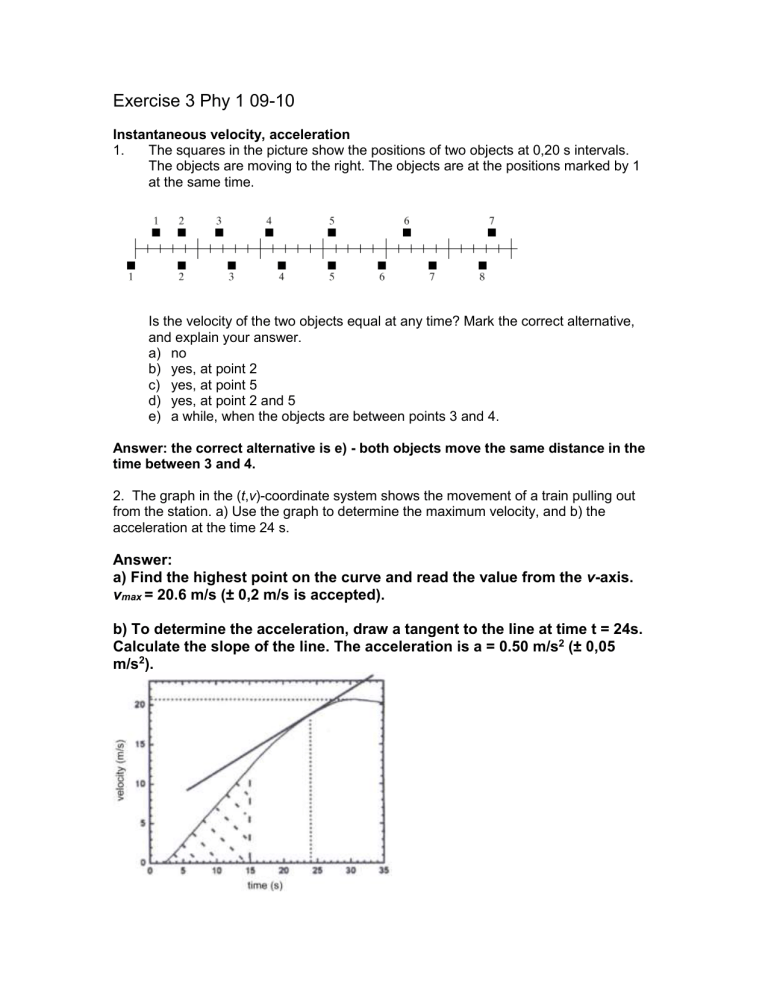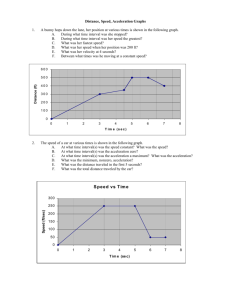Övning 0: Ingångskunskaper Fysik 1 08-09

Exercise 3 Phy 1 09-10
Instantaneous velocity, acceleration
1. The squares in the picture show the positions of two objects at 0,20 s intervals.
The objects are moving to the right. The objects are at the positions marked by 1 at the same time.
Is the velocity of the two objects equal at any time? Mark the correct alternative, and explain your answer. a) no b) yes, at point 2 c) yes, at point 5 d) yes, at point 2 and 5 e) a while, when the objects are between points 3 and 4.
Answer: the correct alternative is e) - both objects move the same distance in the time between 3 and 4.
2. The graph in the ( t , v )-coordinate system shows the movement of a train pulling out from the station. a) Use the graph to determine the maximum velocity, and b) the acceleration at the time 24 s.
Answer: a) Find the highest point on the curve and read the value from the v-axis. v max
= 20.
6 m/s (± 0,2 m/s is accepted). b) To determine the acceleration, draw a tangent to the line at time t = 24s.
Calculate the slope of the line. The acceleration is a = 0.50 m/s 2 (± 0,05 m/s 2 ).
Force
3. When the baseball leaves the hand of the pitcher, it is acted on by air resistance.
What other forces act on the ball? a) The gravity of the Earth b) A force in the direction of motion of the ball c) The gravity of Earth and a force in the direction of motion of the ball c) No other force acts. Choose the right alternative and explain your choice.
Answer: After att ball has left the hand is is only acted on by gravity towards the surface of the earth, and air drag in the direction opposing its motion. The right alternative is a). The hand cannot act on the ball, since it is not in contact with the ball; therefore c) and b) are wrong. If no force acted on the ball it would continue in a straight line without changing its speed, so d) can’t be right.
Figure 1. G is the force of gravity, F v
the air drag. v stands for velocity.
4. A puck glides with a constant velocity from point P to point Q on a horizontal frictionless surface. Air resistance can be neglected. The picture shows the situation from above. When the puck reaches point Q, it is given an instantaneous horizontal hit in the direction of the arrow.
Which one of the pictures (1), (2), (3), (4), (5) shows the path of the puck after the hit?
Why?
Answer: The puck is already moving to the right. The hit does not act on the puck horizontally, so its motion to the right will neither slow down nor speed up. However, the hit accelerates the puck upwards, which gives it a velocity upwards. The two velocities to the right and upwards combine to give the motion seen in picture (2).
Newton’s laws
5. Are the following statements correct or not correct? Why? a. An insect flying in the air is crushed by the windshield of a train moving at high speed. The force of the windshield on the insect is larger than the force of the insect on the windshield.
Answer: False. Newton’s 3rd law states that the forces are equal in magnitude and opposite in direction. Since the mass of the insect is small, the force causes a huge acceleration on it, which breaks it. The train’s mass is huge in comparison, so the force gives it only a minuscule negative acceleration. b. Susan throws a ball upward. After leaving the hand, the ball accelerates upward when it flies upward and downward when it moves downward.
Answer: False. The force of gravity is the only (significant) force acting on it, so there is a downward net force. Therefore, the acceleration must be in the downward direction from the moment she lets go of the ball. c. Steven travels to a distant planet. During the trip, while he is in deep space, almost no gravity acts on him. Therefore, he is weightless. He can pick up a tennis ball with the mass 300 g and a bowling ball of mass 3 kg and throw them both without any difference in effort so that they acchieve the same velocity.
Answer: False. Newton
’s 2nd law states that the acceleration of an object is dependant on the force acting on it, and its mass. The two balls have different masses. In order to give them the same acceleration, Steven must act on them with different forces.
6. The picture shows a graph of the force acting on an object of mass m = 10 kg as a function of time. Interpret the graph, ie describe how the force changes and give the average acceleration of the object in the different time intervals.
Force diagram
10
8
6
4
2
0
0 2 4 6 8 10 12 14 t (s)
Answer: We see that the force increases in the interval 0-4 s, from 0 N till
8N. Since the increase is constant, the average force is 4 N.
In the interval 4-6 s the force is constant at 8 N.
In the interval 6-8s the force decreases steadily to 4 N, the average force is then 6N.
In the interval 8-10s the force decreases to 2 N, the average force is 3 N.
In the interval 10-12s the force is constant at 2N.
Acceleration is gi ven by Newton’s second law, F = ma. We solve for the acceleration and insert the values of the mass and the average force in the different intervals:
0-4s:
F
ma a
F m
a
4N
10kg
0, 4 m s
2
Using the same method for the other intervals:
4-6s: a = 0.8 m/s 2
6-8s:
8-10:
10-12: a = 0.6 m/s 2 a = 0.3m/s 2 a = 0.2 m/s 2





